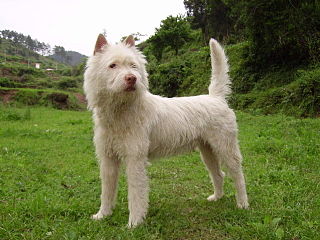Related Research Articles

The chicken is a domesticated species that arose from the red junglefowl, originally from Southeast Asia. They have also partially hybridized with other wild species of junglefowl. Rooster and cock are terms for adult male birds, and a younger male may be called a cockerel. A male that has been castrated is a capon. An adult female bird is called a hen, and a sexually immature female is called a pullet. Humans keep chickens primarily as a source of food or as pets. Traditionally, they were also bred for cockfighting, which is still practiced in some places. Chickens domesticated for meat are broilers, and for eggs, they are layers.

The red junglefowl is a tropical bird in the family Phasianidae. It ranges across much of Southeast Asia and parts of South Asia. It was formerly known as the bankiva or bankiva fowl. It is the species that gave rise to the chicken ; the grey junglefowl, Sri Lankan junglefowl and green junglefowl have also contributed genetic material to the gene pool of the chicken.

Haplogroup M is a human mitochondrial DNA (mtDNA) haplogroup. An enormous haplogroup spanning all the continents, the macro-haplogroup M, like its sibling the macro-haplogroup N, is a descendant of the haplogroup L3.
Haplogroup F is a human mitochondrial DNA (mtDNA) haplogroup. The clade is most common in East Asia and Southeast Asia. It has not been found among Native Americans.

In human mitochondrial genetics, Haplogroup A is a human mitochondrial DNA (mtDNA) haplogroup.

In human mitochondrial genetics, Haplogroup C is a human mitochondrial DNA (mtDNA) haplogroup.

In human mitochondrial genetics, Haplogroup D is a human mitochondrial DNA (mtDNA) haplogroup. It is a descendant haplogroup of haplogroup M, thought to have arisen somewhere in East Asia, between roughly 60,000 and 35,000 years ago.
In human mitochondrial genetics, Haplogroup Z is a human mitochondrial DNA (mtDNA) haplogroup.
Haplogroup O-M122 is an Eastern Eurasian Y-chromosome haplogroup. The lineage ranges across Southeast Asia and East Asia, where it dominates the paternal lineages with extremely high frequencies. It is also significantly present in Central Asia, especially among the Naiman tribe of Kazakhs.
In human mitochondrial genetics, haplogroup E is a human mitochondrial DNA (mtDNA) haplogroup typical for the Malay Archipelago. It is a subgroup of haplogroup M9.

In human mitochondrial genetics, Haplogroup Y is a human mitochondrial DNA (mtDNA) haplogroup.
In human mitochondrial genetics, Haplogroup G is a human mitochondrial DNA (mtDNA) haplogroup.

The Himalayan wolf is a canine of debated taxonomy. It is distinguished by its genetic markers, with mitochondrial DNA indicating that it is genetically basal to the Holarctic grey wolf, genetically the same wolf as the Tibetan and Mongolian wolf, and has an association with the African wolf. No striking morphological differences are seen between the wolves from the Himalayas and those from Tibet. The Himalayan wolf lineage can be found living in Ladakh in the Himalayas, the Tibetan Plateau, and the mountains of Central Asia predominantly above 4,000 m (13,000 ft) in elevation because it has adapted to a low-oxygen environment, compared with other wolves that are found only at lower elevations.

Xiasi Dog or Lower Division Dog is a breed of tugou named after the village of Xiasi, Guizhou Province in China where they have been raised by the Miao people for thousands of years. Historically bred as a hunting dog and watchdog, the Xiasi Dog is prized today for bringing wealth to the family. Today the breed is critically endangered with low genetic diversity and an estimate of only 270 purebred Xiasi left. Xiasi Dogs are now accepted in most Chinese dog shows.

The tables below provide statistics on the human Y-chromosome DNA haplogroups most commonly found among ethnolinguistic groups and populations from East and South-East Asia.
South and West Asia consists of a wide region extending from the present-day country of Turkey in the west to Bangladesh and India in the east.

Camellia taliensis is a species of evergreen shrub or small tree whose leaves and leaf buds are used to produce tea.
The 1833 Kunming earthquake was an 8.0 Mw earthquake that struck the provincial capital Kunming in Yunnan, China on September 6, 1833. The earthquake had its epicenter along the Xiaojiang Fault near the town of Songming, approximately 50 km (31 mi) northeast of Kunming's city centre. The earthquake destroyed many buildings, homes, and temples in Kunming and the nearby countryside. More than 6,000 people died as a result of the earthquake and another 80,000 were displaced. The Qing government at the time provided relief to the region and used the event to strengthen its administration in the province. The 1833 Kunming earthquake was the largest magnitude earthquake in Yunnan's recorded history.
This article summarizes the genetic makeup and population history of East Asian peoples and their connection to genetically related populations, as well as Oceanians and partly, Central Asians and South Asians, which are collectively referred to as "East Eurasians" in population genomics.
The Changhua River, also known as Changhua Jiang, Chang River (昌江), is a river located in Hainan Province of the People's Republic of China. and is the second longest river in Hainan.
References
- ↑ YE Lang-hui HUO Jin-long MIAO Yong-wang , * ZHU Sheng-quan CHEN Tao LIU Li-xian PAN Wei-rong BI Bao-liang. Genetic Diversity Analysis of Nixi Chicken Using Microsatellite DNA Markers. Zoological Research, 2006, 27(1): 68-74.
- ↑ Huo, J.L.; Wu, G.S.; Chen, T.; Huo, H.L.; Yuan, F.; Liu, L.X.; Ge, C.R.; Miao, Y.W. (2014). "Genetic diversity of local Yunnan chicken breeds and their relationships with Red Junglefowl". Genetics and Molecular Research. 13 (2): 3371–3383. doi: 10.4238/2014.april.29.16 . ISSN 1676-5680.
- ↑ Gu, Jingjing; Li, Sheng (2020-07-02). "Next-generation sequencing of the complete mitochondrial genome of the Nixi chicken (Gallus gallus)". Mitochondrial DNA Part B. 5 (3): 3271–3272. doi: 10.1080/23802359.2020.1810593 . PMC 7781923 .